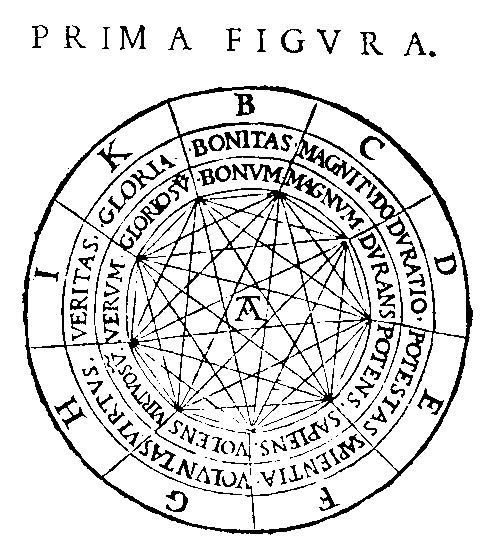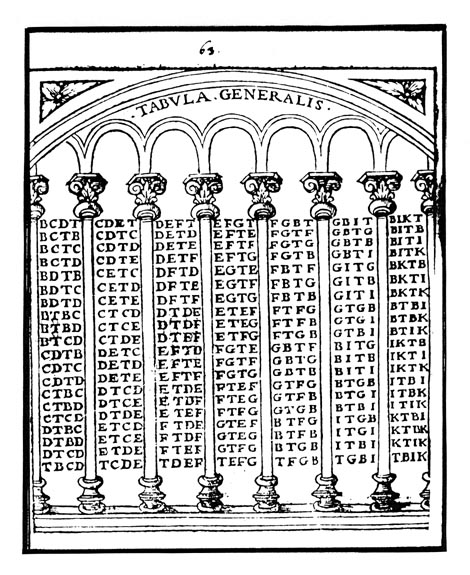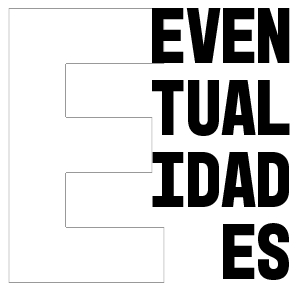

fonte: The birth of the MACHINE: Raymundus Lullus and His Invention, de Werner Künzel
http://www.c3.hu/scca/butterfly/Kunzel/synopsis.html
A ars combinatoria, criada por Raymundus Lullus, e especialmente as máquinas geradoras de texto que ele inventa neste contexto, são consideradas como uma origem secreta da computação (cuja lógica, testada em mainframes rodando Cobol e Assembler, mostra-se funcional):
“Das System schluckt die Geschichte un läßt so vergassem, daß es seinerseits mine solche hat. Uns aber hat sie nicht mehr losgelassen, seit wir von Jahren an die Schriften des mittelalterlichen Theologikers Raimunds Lullus gerieten. Seine logischen Modelle haben wir in die Computersprachen Cobol sowie Assembler übertragen und sie in einen Berliner Großrechner eingegeben”. http://bit.ly/1eCW03o
“When, in about 1275, Raymundus Lullus invented his logical machine, the Mediterranean Sea was a kind of interface for three expanded cultural streams. Spain in general, and specifically the island of Mallorca, was at that time, one could say, a melting pot for the three religions which have determined the history of the world until the present. There was an encounter of the Christian religion with the culture of the Muslims, as well as a very important trace of the Jewish tradition. Raymundus Lullus began his work just a short time after the successful “reconquista” of Spain, which would not conclude until 1492. It is therefore necessary to regard his invention as embedded within a special situation, i.e., embedded in a deep crisis of communication.”
“With the Ars combinatoria of Raymundus Lullus, a real revolution of formalistic thinking was born, as this was the first known text-machine which was able to produce true (and, needless to say, false) declarations in a strange mechanical manner.”
“The radical innovation Lullus introduced in the realm of logic is, in fact, the construction and the use of a paper-machine to combine elements of thinking, which means of course, elements of language! With the help of connected geometrical figures, following a precisely defined framework of rules, Lullus tried to produce all the possible declarations of which the human mind could think. These declarations or statements were nevertheless represented only by a series of signs, chains of letters.”
“Thus, his great invention was the idea of producing the totality of human wisdom by a mechanical method of combining a strictly limited quantity of signs.”
“Just reading chains of letters, one may say. Then what is the use of that strange machine? Giordano Bruno, Athanasius Kircher, Gottfried Wilhelm Leibniz, Stephan Mallarmé, Jorge Luis Borges and Antoni Trpies have all valued this use, and you will understand the reason for their admiration with the following description. Regarding the next original design 2, we come a little bit closer to the trick of this machine: every single letter, from B to K, represents far from merely itself — not only one meaning, but several strictly defined and placed meanings! Every single letter – a fantastic invention – every letter is a kind of an interface! Writing the letters from B to K as key-terms heading a table, series of different words can be easily constructed. For example, B=Bonitas, C=Magnitudo, D=Duratio, E=Potestas, F=Sapientia, G=Voluntas, H=Virtus, I=Veritas and K=Gloria. This is, initially, the paper-circle called the Prima Figura. The next strictly defined table of words can be produced on the next circle, perhaps as seen on the Secunda Figura 3, where we find categories and relations of thinking.”
“Lullus established tables incorporating the subjects of all areas of human wisdom, material from theology at first, but later, material of the philosophical tradition, the natural sciences, and so on. Thus, when the machine was ready and the tables were chosen, it was very easy to read and write down all the combinations produced by turning the paper disks step by step.”


